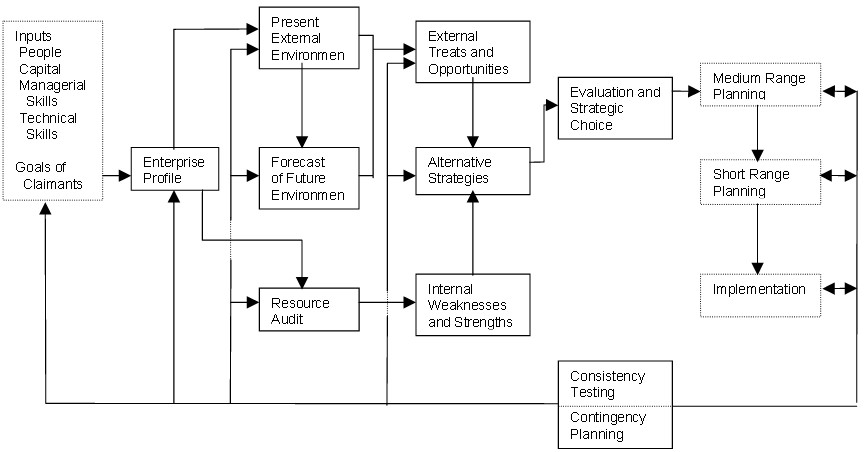Planning involves selecting missions and objectives and the actions to achieve them, it requires decision making, and that is choosing future courses of action from among alternatives. There are various types of plans ranging from overall purposes and objectives to the most detailed actions to be taken, such as ordering a special stainless steel bolt for an instrument or hiring and training workers for an assembly line. No real plan exists until a decision – a commitment of human or material resources or reputation – has been made. Before a decision is made, all that exists is a planning study, an analysis, or a proposal: there is no real plan.
Although specific steps in the formulation of the strategy may vary, the process can be built, at least conceptually, around the key elements shown in Figure.

Inputs: The inputs from the external environment may include people, capital, and managerial skills, as well a technical knowledge and skills. In addition, various groups of people will make demands on the enterprise .For example employees want higher pay, more benefits, and job security. On the other hand, consumer demands safe and reliable products at reasonable prices. Suppliers want assurance that their products will be bought. Stockholders want not only a high return on their investment but also security for their money. Federal, state and local governments depend on taxes paid by the enterprise, but they also expect the enterprise to comply with their laws. Similarly, the community demands that the enterprise be ‘good citizens ‘providing the maximum number of jobs with a minimum of pollution. Other claimants to the enterprise may include financial institutions and labour unions even competitors have a legitimate claim for fair play.
Enterprise Profile: The enterprise profile is ua1ly the starting point for determining where the company is and where it should go. Thus, top managers determine the basic purpose of the enterprise and clarify the firm’s geographic orientation, such as whether it should operate in selected region in all states in the United States, or even in different countries. In addition managers assess the competitive situation of their firm.
Orientation of Top Managers: The enterprise profile is shaped by people, especially top managers, and their orientation is important for formu1ating the strategy. They set the organizational climate, and they determine the direction of the firm. Consequently, their values, their preferences, and their attitudes toward risks have to be carefully examined because they have an impact on the strategy.
Purpose and objectives: The purpose and the major objectives are the end points toward which the activities of the enterprise are directed. The present and future; external environment must be assessed in terms of threats and opportunities. The evaluation focuses on economic, social, political, legal, demographic, and geo- graphic factors. In addition, the environment is scanned for technological development, for products and services on the market, and for other factors necessary in determining the competitive situation of the enterprise.
Internal Environment: Similarly, the firm’s internal environment should be audited and evaluated in respect to its resources and its weaknesses and strengths in research and development, production, operations, procurement, marketing, and products and services. Other internal factors important for formulating a strategy include the assessment of human resources, financial resources, and other factors such as the company image, the organization structure and climate, the planning and control system, and relations with customers.
The various strategies have to be carefully evaluated before the choice is made. Strategic choices must be considered in light of the risks involved in a particular decision. Some profitable opportunities may not be pursued because a failure in a risky venture could result in bankruptcy of the firm. Another critical element in choosing a strategy is timing. Even the best product may fail if it is introduced to the market at an inappropriate time. Moreover, the reaction of competitors must be taken into consideration. When IBM reduced its price of the PC computer in reaction to the sales success of Apple’s Macintosh computer, firms producing IBM-compatible computers had little choice but to reduce their prices as well. This illustrates the interconnection of the strategies of several firms in the same industry.

